Connections & Reflections: A Visual Learning Gestalt
Hello People,
Making Connections:
Unfortunately, I have not been able to post in proper sequences this term, so please forgive the late entry here. Also am hoping the size of the visual works better, it shows up fine on the preview….am hoping it does not shrink as it did on my last post[!]
An attempt at a visual gestalt: Reflections on ETEC 540
This is my attempt at constructing a visual representation of my own personal learning trajectory through ETEC 540. I really believe that the more complex the information, the more important the visual component [as a way of communicating] becomes.
Ideas around Connections: New Knowledge
The ideas I was working with here including trying to map out how course content [the four modules] and topic areas [the remediation of writing and the legacy of orality] tracked through western cultural and political history, fused with my own prior knowledge and with the incredible resources available [including other students and online media] to create new knowledge for me.
Fusion of Content:
Content is so rich in this course [including contributions from fellow students] that all that is shown here are broad strokes and highlights of major subjects, authors and texts within ETEC 540. It is not meant as a comprehensive representation of the course, but more as a visual aid, a conceptual window into one student’s personal learning path, reflections that fused with conceptual connections, to form a kind of visual gestalt.
Thank you! to everyone for all the information shared, learned a tremendous amount from those around me in this course, as usual.
Yours,
Barb
Here is the Visual:

December 1, 2009 4 Comments
Hypertext in Cyberspace: A new genre & A new way of learning?
Hypertextuality in Cyberspace: A new genre and a new way of learning?
Commentary #3 [pp 26 -28 Bolter text: ETEC 540]
The use of technology for communication, the digital “word processor” and in particular the advent of the use of “hypertext” within electronic media has fundamentally altered communication, the ways we use language and twenty-first century e-learning environments. Digital modes of communication and potentially hypertextuality itself may result in the creation of more knowledge (Heim, 1987) and reshape or reconfigure our ways of thinking in positive and creative ways (Kamin, 1984). In his book, “Writing Space: Computers, Hypertext & the Remediation of Print” Bolter asserts that hypertext enables a specific type of remediation [a process involving the transition from one media to another] that allows for the emergence of a distinctive and new genre. A review of what is meant by the term “hypertext” as Bolter uses it will begin this discussion followed by an overview of three important features that distinguish it from its predecessor [print media] including it’s immediacy, flexibility and interactivity (Bolter, 2001). Finally, a specific type of learning that is uniquely enhanced by hypertext will be examined through the lens of its conceptual or theoretical support in constructivist learning theory (Mahoney, 2003).
To begin, the term “hypertextuality” is no longer “…esoteric…” but is understood by most people within every day speech, and is indeed now, at the beginning of the twenty first century, a term that is a part of our “…common cultural knowledge” (Bolter, pp27). Hypertext as defined by Bolter means “…a network of interconnected writings…” of pages of information that “…may be of equal importance in the whole text…”(Ibid, pp 27). It is more than the electronic equivalent to footnotes in a book, because as indicated above, the information that is provided may be fundamental to understanding the main body of the text (Ibid, 2001).
Bolter refines his definition of hypertext to include some broad characteristics, including such things its immediacy; versus for example a footnote in a printed book, cited from a specific printed resource. In the book format, following up on a footnote, can be a very time consuming and labour intensive activity.
Two other major components of hypertext include its flexibility and interactivity, features that according to Bolter help to transform electronic writing into a new mode and genre, that of hypertextuality (Ibid 2001). The flexibility of the use of hypertext operates on a number of levels, helping it to serve both informational and rhetorical purposes. Hypertext links can clarify meaning [contextualized to a specific use] and lead the reader back to the text or it can prompt the reader to explore entirely different sites or nodes of information related to the topic. Hypertext also encourages different types of learning styles involved in knowledge acquisition and according to some psychological literature, to ways of thinking and of cognition also (Mahoney, 2003).
Bolter asserts that hyper textual links are associative in terms of their impact on knowledge acquisition. Constructivism is just one of the major learning theories that provides conceptual and theoretical support for Bolter’s argument that hypertext is not only a different genre but supports also a different way of learning and acquiring knowledge and information. Hypertextual learning is facilitated in keeping with Constructivist notions around the importance of the search for Meaning as both an impetus for and outcome of, the process of Learning.
Within this larger theory, the principles of Engaged Participation, encouraged by the structure of hypertext itself is further promoted by facilitating unique virtual and conceptual links between the material and the reader/learner. In tandem with this feature of interactivity, hypertext also encourages synchronous movements and unique learning pathways through the virtual ‘text’.
An analysis of the process of reading and learning involved in the use of hypertext, quickly reveals that like psychology, not only are there many theories of learning, no one learning theory fits every use or application of hypertext (Jonassen 2003). Moreover, and drawing on this same parallel example, what is best for the learner [or patient] may be a combination of learning paths rather than a unity, a requirement that hypertext readily facilitates.

Hypertext and Learning: as The Search For Meaning
One of the many layers of the complexity of hypertext in terms of its functionality in e-learning contexts is its ability, from a Constructivist perspective, to provide the learner with Meaning, which is as noted above, the primary impetus for learning in this view. Hypertext provides a web of meanings, a configuration that is constructed uniquely and actively by each student, driven by their own needs and particular learning objectives and styles.
Complementary to the use of the hypertextuality in constructing meaning is its enhancement of interactivity as students engage with the layers of information provided within in a specific topic area. A self created trajectory through the electronic text enables the individual to effectively embed content more firmly within their own pre-existing schemas or world view, resulting in more comprehensive assimilation of information, better retention or memory of key concepts, and greater practical application of the new knowledge or skill (Sutherland 2001).
The notion of conceptual coherence is also inherently woven into and throughout hyper textual materials and allows innovations and improvements to learning materials by providing flexibility to the instructor or curriculum designer, in terms of its format, structure, and choice of pedagogical methodologies (Sutherland 2001).
A critical feature of hypertextuality is that it can provide a conceptual framework, not only for the design of virtual curricular elements but also in supporting a cognitive substructure from which key concepts and learning objectives can be constructed. Importantly, hypertextuality as a learning tool, also demonstrates an effective translation of learning theory into practice, by facilitating and encouraging students to arrive at the same learning objective via their own unique cognitive or conceptual pathway.
To sum up, key elements of hypertext including its immediacy, flexibility and interactivity extend the reach of the both the type and the scope of the information provided. Bolter provides an effective argument [only briefly touched upon here] to support his contention that hypertextuality provides not only a remediation from print to digital media but that it also expands the parameters of the medium itself sufficiently to be considered a new genre. Finally, in an e-learning context, hypertextuality also enables new ways of reading, thinking and of learning, which are given conceptual support by Constructivist learning theory.
Digital Image:
Created using CMap Technology
References
Bates, A.W., Poole, G. (2003) Effective Teaching with Technology in Higher Education
Jossey-Bass, San Francisco, USA
Bolter, J.D. (2001) Writing Space: Computers, Hypertext and the Remediation of Print
2nd Edition, Lawrence Erlbaum Associates, Inc., Publishers
Carvin, A. (1998) Constructivism Basics
Ed Web: Exploring Technology and School Reform
http://www.ibiblio.org/edweb/constructivism.basics.html
ETEC 540: Module 4 (November 2009) Hypertext
Masters in Educational Technology, online course material, UBC
Jonassen, D. (2003) The Vain Quest for a Unified Theory of Learning
American Journal of Distance Education
Heim (1987) cited in ETEC 540 Module 4: Idea Processors & the Birth of Hypertext
Retrieved online from Readings, 4Nov2009
Kamin, J. (1984). The Think Tank Book. Berkeley, CA: Sybex.
Retrieved online from Readings, ETEC 540 Mod 4Nov2009
Mahoney, M.J. (2003) What is Constructivism and Why Is It Growing?
Presented at the 8th International Congress of Constructivism and Psychotherapy, Italy, June 2003
The Society for Constructivism in the Social Sciences; website
http://www.constructivism123.com/
Postman, N. (1992) Technopoly: The Surrender of Culture to Technology
Vintage Books, New York, NY
Sutherland,P. (2001) A Lifelong Learning Journey; Utilizing Piaget’s and Biggs’ theories of development
Education Line Article, University of Sterling, Scotland
http://www.leeds.ac.uk/educol/documents/00002580.htm
Thomas, M. (2002) Gestalt Learning Theory for Dummies
Minot State University
http://www.misu.nodak.edu/psych/Burke/book/gestalt.htm
November 24, 2009 1 Comment
Heavy Heroes: More than just memorable
The Cultural and Psychological Roles of Heroic ‘Heavy’ figures and of the Bizarre in Ancient Mythology: More than just memorable
Walter Ong asserts, in his discussion [pp 69 -71] that the heroic tradition [meaning the great works of Homer (the Iliad, the Odyssey et al)] and the great pantheon of gods of ancient mythology, specifically that of the Greeks, was an outcome of the inherent characteristics of “primary” oral culture and of early literate culture. According to this interpretation of the attributes of oral culture, oral residues include a necessary structural mnemonic component in terms of what is included in works of poetry and literature. Ong states that these works include what he has termed “…type figures, wise Nestor, furious Achilles, clever Odysseys….” that is, that these figures constitute typologies. (Ong, 2000 pp 69). It will be shown in this discussion that, these ancient works do indeed present specific “types” but that their appearance function primarily as expressions of cultural values and psychological types, which has very little to do with mnemonics.
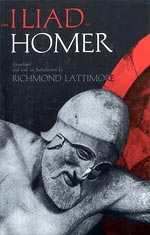 A culture of War [1]
A culture of War [1]
It will be shown that these stories arose out of an evolutionary meshing of critical points of juncture, framing a “space” where personal & psychological history and cultural values and mythology complexly intersect. It will be demonstrated that it is not the needs of an orality based culture but the language of the Unconscious and the needs of a military based culture, that provided the impetus for the creation of the bizarre psychological types and “heavy” dramas that are portrayed in these works.

More than just a clever ruse: An ancient psychodrama [2]
The connection between psychoanalytic theory [especially Freudian and Jungian] and literature [especially ancient classical mythology] is intimate and complex, indeed among the honours Freud received in his lifetime, was the prestigious Goethe Prize for Literature (Nelson, 1963). In Freudian psychology, many of the fundamental concepts, [for example parapraxis, dreams, symptoms] have direct analogies within literary theory. Specific psychoanalytic constructs constitute a sort of involuntary language, with its own laws and logic, which serve to define and describe the operation and nature of the Unconscious, within the Freudian concept of the psyche [Orlando 1978].
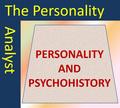 Personality and History fuse together in Psychoanalysis [3]
Personality and History fuse together in Psychoanalysis [3]
Mythology and mythological analogies are fundamental and integral to the central theoretical construct of Freudian psychological theory; the Oedipus Complex, which is based upon Sophocles Oedipus Tyrannus {Morford & Lenardon, 1991]. It would be dismissive of the entire field of psycho-analysis [and of much “talk therapy”] to conclude that the roots of the frequently bizarre and strange characters from these ancient stories is driven by the need to make them memorable in the sense of easier to recall, rather than by a fusion of complex psychological and cultural values, needs and characteristics.
It has been suggested that the Iliad reveals not just the attributes and characteristics of the Heroes and the gods of the mythological world but also serves to illuminate many aspects of features of Homeric and Classical Greek culture, providing insight into the ways that the Greeks viewed or perceived themselves and their society (Armstrong, 1993).

A cast of characters expressing psychological types and cultural values [4]
In terms of values or ethics, it is clear that within the mythical world of the Iliad, human beings are continually and dramatically playing out their predestined roles within specific well-constructed constraints, which are imposed upon their agency or range of actions, by the gods. Human beings are controlled by and subservient to, various levels or hierarchies of power [both divine and human] and domination.
Not surprisingly, in a world defined by graduations or degrees of tyranny [with the great warring kingdoms as political models], and within a story chiefly concerned with the consequences of war, the virtues [or passions] manifest in the Heroes of the Iliad [Achilles, Hector, Priam] are those that fit a military paradigm of ‘greatness’. Thus, martial values are asserted, among them, two extremely praised attributes are those embodied in the concepts of “Honour” and “Glory” defined within a specific set of military values and ethics [sic] of Greek military, partriarchical, tyranny based culture.
In summary, the story of the Iliad is clearly concerned with asserting the validity of the ‘honour culture’, which the Greeks held in such high esteem though the actions and examples of both gods and men. The power relationships between man and the divine are interactionist, that is, the same passions and character flaws plague both the Heroes and the deities. The gods participate in aspects of humanity and the Heroes participate in aspects of the divine in a complex and dialectical fashion. Nowhere in all of this, whether in terms of cultural values or in terms of psychological needs, does the role of mnemonics figure as having primacy.
 Achilles: A Postmodernist Hero? [5]
Achilles: A Postmodernist Hero? [5]
Ong asserts the notion that mnemonics, and the needs of orality [as though it was in itself an entity] or of an oral based culture, are more important than the cultural values or psychological forces at play here. Ong states “…. all of this not to deny that other forces beside mere mnemonic serviceability produce figures and groupings….” and that “…psychoanalytic theory can explain a great many of these forces…”. Clearly, psychoanalytic theory and cultural forces explain the vast majority of factors at work, and mnemonic structure [like the well documented use of repetition of phrases and of whole scenarios] was a secondary, even minor attribute to these great works. The critical or primary function of these works was to support or validate cultural beliefs [representing specific values] and to express the language of the unconscious [through the representation of universal attributes] as it functions within the human psyche.
The importance of the universality of some of these values, the cultural specificity of others, and the deep psychological underpinnings of these characters and their behaviors, can be dismissed if taken at surface value. However, such surface interpretations can be misleading. These stories portray humans as being at the mercy of, or aided by, divine powers, with questions about mortality and morality often left unanswered. Indeed the great questions posed in stories like the Iliad are not resolved, and seemed shrouded forever in ambiguity.
For me these stories resonate well in our highly technical and highly literate society, even these thousands of years after they were passed down to us. These works are not merely bizarre stories from the past, made easier to remember because of their strange set of characters. Ambiguity itself is asserted within them [a very post modern concept] and functions as a sort of mythic signifier or semiotic sign, of those realities that constitute the significant and universal components of the human experience and of what it means to be human.
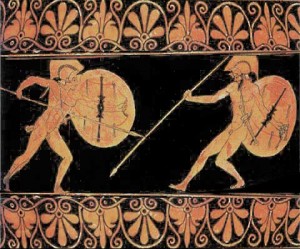
An eternal conflict plays out in the human psyche as well as the battlefield [6]
November 16, 2009 2 Comments
An overview of a remediation: From Scroll to Codex
An overview of a Remediation: From Scroll to Codex
Introduction:
Writing as a mode or method of human communication, has been in existence for a very long time and has been continuously evolving, progressing, regressing, moving forward, and changing (Botero et al 2000). These processes of change, these transitions or remediations of ways of writing, reading and of knowing are shaped by and acted upon complex socio/political and historical/cultural forces that continue to inform our ways of communicating today, at the cusp of the twenty first century (Bolter 2001).
A brief overview of the trajectory of a specific remediation, that of the transition from the primacy of the use of the Scroll as a way of storing and communicating written text and knowledge into that of the Codex will be the focus of the discussion to follow. Remediation here will specifically refer to the movement from one media or mode of written communication to another as described in Jay Bolter’s work about writing in the context of the advent of computers (Bolter, 2001). It should be noted that the outline of the cultural and political forces at play is limited here not only to a specific western and Eurocentric context but also to a specific chronological period or range, with a primary focus on the late Roman period extending to about the third century AD. This particular remediation traces a fascinating and complex path, weaving a trajectory through great cultural and historical shifts that occurred over a period of several hundred years.
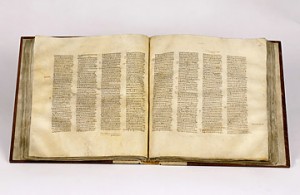 Scroll to Codex: One of the First Bibles [1]
Scroll to Codex: One of the First Bibles [1]
Writing in its many forms has always communicated the literal content of the text, however, the information contained within the text and the way and the format in which it is presented communicates much more (Edney, 1992). The Scroll and the Codex “speak” of or describe the extant power relations of the historical moment, and in many ways also of the specific culture from which it emerged. Writing delineates and reflects specific epistemological systems and communicates what a specific culture considered important enough to be considered Knowledge (Mokyr, 2002).
Moreover, the act and process of writing is not a neutral one; nor are compilations of writing, whether contained in Scroll or books, neutral artifacts. Where ever writing appears and in whatever technological form it manifests, it bears the very specific imprint of the cultural, political and economic influences that shaped and created it (Bolton ibid). This holds true for all forms of writing over the vast expanses of recorded history as they are all grounded in the specifics of their unique cultural and historical milieu. From the ancient hieroglyphics of Egyptian dynasties, to the letters on the papyrus Scrolls of the ancient Greeks or the illuminated manuscripts of medieval Europe, from the printed pages of industrial era texts to the digital traces of keystrokes in the email communications of modern societies; all reveal and reflect the culture and the power relations within that specific historical moment or epoch.
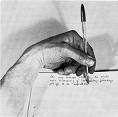
The act of Writing: framed by culture and by history [2]
This discussion will demonstrate that the remediation of writing on the Scroll as it reconfigured and resituated itself into the technology of the Codex was enabled by a unique set of cultural forces, and was framed by the socio-economic and political power relations of a specific historical context.
A brief introduction to the terminology used here and the historical and cultural contextual backdrop to this transition will begin the discussion, and an examination of the changes that occurred to transform the Scroll into the Codex will follow.
Terminology:
Remediation as used by Bolter is a process, it describes the transition from one media or mode to another, it is dynamic [not static] it has the potential to be and frequently is, evolutionary, but not necessarily logically progressive. It is a series of changes, but they are not simple or linear trajectories of change. The process of remediation may involve simultaneous progression and digression, and tangential leaps forward followed by regressive movements away from positive innovation. All of these changes involve a myriad of forces and or characteristics having nothing inherently to do with the actual media or medium itself (Bolton ibid). To sum up, the process of remediation of modes of communication is as complex as the historical and cultural forces that shaped those changes.
 An example of Graffiti: late twentieth century writing [3]
An example of Graffiti: late twentieth century writing [3]
A similar qualification must be placed upon the meaning of Codex. Although it evolved over time to have a specific meaning within legal contexts, in our examination here the term Codex will denote leaves of wood, papyrus, and more frequently, to parchment, bound together into the form of a modern volume, or what is commonly referred to as a book.
When referring to the term Scroll we are going to define it for the purpose of our discussion here as very simply a roll of paper [originally papyrus] or of parchment, usually, having writing on it.
The Process of the Remediation of Writing:
The remediation of writing is complicated because the process is not only driven by functional or rational requirements, that is, it is not just a series of what could be evolutionary or progressive innovations or improvements to a particular medium [employed as communication device] over time. Nor according to Bolton, is there a clear division or cut off between the use of one medium to the other.
Writing is Knowledge & Knowledge is Power:
Throughout history the use, access to and control of modes of writing, has been recognized by all cultures, as was noted above, not just for its inherent importance as a way of communicating, but also as an effective way of demonstrating and communicating power. Therefore, what is conveyed within a specific scroll or codex [or book] has always been something more than just its literal, surface or even just its cultural meanings. Writing and the information a civilization formulates into knowledge, as it manifests and is contained in scrolls and in books, issues out of a complex mixture of cultural and historical forces that frame and represent specific ways of perceiving and of interacting with the world (Lunsford 2006). These cultural and historical forces fuse with ways of knowing [systems of knowledge and knowledge acquisition or learning] that are specific to each unique context. All cultures in the western context from the very earliest of times, seem to have shared a recognition that being able to control the distribution, the storage and the access to knowledge [including what is left in and what is excluded from that corpus] that is incorporated within written texts, is both central to the control of societies [and its people] and is a secure gateway to power (Mokyr, 2002). Knowledge, so they say, is power.
 Ancient Greek Library: Artists rendition [4]
Ancient Greek Library: Artists rendition [4]
Writing, as a mode of communication, has been a hallmark of human civilization since the beginning of what has become know as history. History as a compilation of the writing of those who were in power, tracks a series of social, cultural and political transitions, involving the rise and fall of human cultures and civilizations over time as seen through the lens of those political and historical power structures and institutions. Many of the same forces [power dynamics, economics, regional and geographical realities] that shaped these historical shifts also determined the shape of the transition from Scroll to Codex.
The Primacy of The Scroll:
An ancient writing technology evolves and then fades away
The Scroll in its many forms, was used over a period of over three thousand years and as a writing and communication device, was the first record keeping technology that allowed changes, revisions and/or edits to be made. Early scrolls were developed using papyrus, a reed native to ancient Egypt, found in abundance along the banks of the Nile River and in marshes throughout the region. The Egyptians perfected the use of papyrus and developed procedures and instructions on how to best prepare it. In an elaborate process, the reeds of the papyrus plant were cut, peeled, moistened and pounded out into layers. The layers were pressed together to form sheets, left to dry and then finished, by rubbing with stones or shells, into a smooth surface suitable for writing on (Szirmai, 1990).
 An example of ancient Egyptian {light} papyrus [5]
An example of ancient Egyptian {light} papyrus [5]
A significant and early form of the scroll was the ancient Hebrew text contained within the Torah [3300 BCE]. However, traditionally the use of animal skins, treated in special ways, was employed for the surface of the “page” or viewing area of the Torah. The history of the Torah Scroll, along with its many fascinating and elaborate traditions [in terms of transcription practices and protocols] is a bit of an anomalie, in terms of forms of writing in the Scroll format.
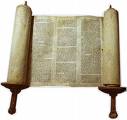 The Torah Scroll [6]
The Torah Scroll [6]
The papyrus scroll was much more common. It was developed chiefly in its early forms by the Egyptians, then modified also by the Greeks and further developed later by the Romans. Over time it became more & more refined and somewhat more practical in its applications.
Papyrus Scrolls: the medium of choice for centuries
The inherent features or characteristics of papyrus determined certain features of the Scroll. For example, only specific areas of the plant could be used for the creation of papyrus, and the size of the both the width of the scroll and its length was limited. That is, beyond certain parameters the papyrus page would simply fall apart and of course there were limits to how big a scroll could be, just as there were very real limits to how much text could be viewed at one time, as it was unrolled for reading (Szirmai, 1990).
Early Greeks like the Egyptians, recognized how important the control and storage of knowledge was to the success of an empire. Unfortunately, many of the great libraries, such as those of the Babylonians and of the early Greeks, are known to us only through descriptions of their grandeur in the writings of ancient scholars. Much as been said for example, of the great scroll based libraries of ancient cultures, such as those of Solomon and of Alexandria (Gibbons, 1877). Early recognition of the esteem in which these receptacles of knowledge were held, is reflected in the prestige which attached to the leaders who deliberately acquired them in their conquests, and to the grand and impressive architecture that was created to house them.
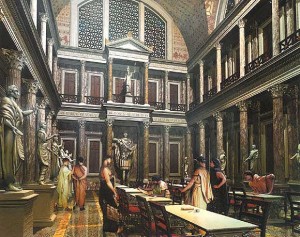 A monument to Roman Knowledge & History:
A monument to Roman Knowledge & History:
Interior of Trajan Library Artist Concept [circa 53 -177 a.d] [7]
Roman Ingenuity improves the Scroll:
By the time that the Scroll was being used by the Romans, many auxiliary technologies for the viewing and storage of the scroll had evolved. Special tables and podiums were developed which allowed for maximum viewing of areas of the scroll, and for reading and for writing on the scroll, which improved the efficiency and practicality of their use (Szirmai, 1990).
Eventually, Roman scholars and officials specified optimum measurements for scrolls, standardized its manufacture and developed guidelines for its overall appearance. Best practices included standards for width, length, colour and smoothness as well as the overall appearance of top quality scrolls. It should be noted that papyrus, throughout its time as the most favored writing medium, was always an expensive item. Writing, reading, having access to knowledge and to the materials required for writing, was the privilege only of the elite ruling classes, and was never something that the average citizen would have had access to (Roberts, C.H., 1984).
The Message is the Problem: Inherent flaws in the Medium
Part of the remediation of the scroll to codex involved the recognition by the Romans in particular, as the last great cultural inheritors of the Scroll, of some of the difficulties inherent in the medium, even with all of the accommodations, [such as special tables and podiums] that had been made. These problems including that it was difficult to move forward or backward within the scroll itself. In fact, there were many cases where this difficulty resulted in mistakes by scribes [those responsible for copying texts] who either accidentally missed sections of text [fragmentation of texts] or who unnecessarily repeated sections of text [because the section already recorded was not easily viewed].
Storage and Transport of Scrolls:
Storage of scrolls was always challenging, as noted above, it was limited by the strength of the papyrus, which delineated the maximum length of the scroll. It was a fragile medium at best, even when it was reinforced. Sticks, rods, or rollers made of wood or of ivory were inserted within the scroll to try and reinforce and support them but scrolls were always in danger of collapsing altogether or of bending and cracking in the middle (Roberts, 1984).
Papyrus scrolls could be damaged quite easily by moisture and needed special containers for both storage and transport. Sheets of papyrus that were pounded together [known as rolls, within the larger scroll] taken together, could not exceed a specific size, the maximum length was about 15 feet. It was the parameters of the technology, in terms of the maximum length for the document itself and the size and quantity of the sheets or rolls of papyrus within the Scroll that determined both how long a document it could be, and determined how it could be divided into segments or sections.
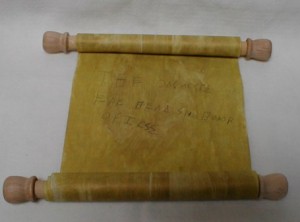 Early Greek Scroll showing wooden rolling sticks [8]
Early Greek Scroll showing wooden rolling sticks [8]
Sections or partitions of works contained within scrolls were very much defined by the medium, just as manuscripts at a later time were influenced by the format of books. These sections or partitions gradually transformed, eventually forming the familiar sections or chapters, of the codex or book. These parameters determined also the amount of viewing and writing “space” [known as the paginae, later to become the page] and the amount of text that could be communicated within the viewing area [estimated at between twenty and fifty lines] (Roberts, 1984). These characteristics became standardized features so that the work involved in unrolling and re-rolling the scroll was kept to a minimum. Even so, reading and writing using scrolls, was a fairly labour intensive activity and every time the scroll was manipulated it was at risk of being damaged.
Shelving with holes in it [like the cubbyholes of a post office] was used for the storage of scrolls, but when several scrolls collected together were required [like the chapters or sections of one book] a container called a book box was employed to store the work. Marking, labeling and storing of libraries filled with scrolls was very difficult and again the limitations of the medium itself determined how many scrolls could be contained together and how they were stored.
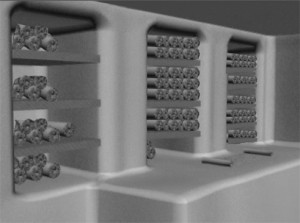 Scroll Library of Qumran:
Scroll Library of Qumran:
Reconstruction of Qumran’s Library (illustration S. Pfann, Jr.) [9]
Pens filled with ink, were the mostly common implements used for writing on papyrus. Early pens were fashioned out of a variety of materials. Some pens were made from reeds, some were carved out of wood, and some were formed from bronze or of copper sheets that were shaped into vessels that were filled with ink. Ink was made from a variety of substances, such as ash or soot, the ink from cuttlefish or octopus, or from resin, sometimes the residue of wine [the proverbial dregs] was used for ink also (Lunsford, 2006).
A temporary alternative leads the way to a permanent solution: The Tabula Cerata
Although papyrus scrolls were expensive, difficult to edit and challenging to store and transport, fortunately, there was always, a less expensive alternative. In tandem with the advent of the scroll an auxiliary technology for short term and unofficial or casual and temporary, communication needs was used. Even during the time of the primacy of the scroll, the use of the Tabula Cerata [or the wooden writing tablet] was the medium of choice for many, such as students practicing their writing skills, for business people and merchants who had quick and frequently cryptic information to impart, and for unofficial internal government communications. These tablets usually had two leaves [two was the most common number of leaves but there could be as many as four to an upper limit of ten] which were thin pieces of birch or alder, treated with a surface of smoothed out wax that could be written or inscribed on, with a metal stylus or pen (Szirmai, 1990).
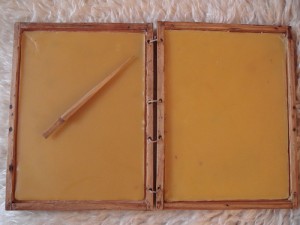 An example of the Tabula Cerata shown with stylus or wooden pen [10]
An example of the Tabula Cerata shown with stylus or wooden pen [10]
Roman Necessity as a Driver of Innovation:
As mentioned above the use of papyrus reigned supreme for a very long time, with the notable exception of the Hebrew tradition [and the production of the Torah in particular] that employed the use of parchment of made from animal skins. However, a set of circumstances caused a break in the flow of the distribution of papyrus and the resulting temporary shortage of the material in tandem with modifications to the wooden writing tablet, congealed to create an innovation, a shift, a remediation that laid the way for the final transformation of the Scroll into the Codex.
There is some controversy as to when and why there was a shortage of papyrus supplies, but there is consensus that it was the temporary inability of the Romans to import papyrus that forced a search for alternatives and resulted in the first real transition from the use of the scroll to that of the earliest forms of the Codex (Szirmai, 1990). The refinement of the early Tabula Cerata was among the many inventions and innovations of Roman culture. Parchment began to replace the more cumbersome wooden sheaves or leaves of the wooden tablet. Because of their pliability and because the leaves were so much thinner, the amount of sheets that could be contained, immediately increased, moving from [as above] the usual two, to as many as sixteen to pages within one tablet or book. It was the flexibility of the parchment that made the difference; it could be folded or bent without breaking or falling apart.
From Scroll to Tablet: From Tablet to Codex:
The early uses of these tablets remained chiefly for temporary or business communications that were brief and/or repetitive, so the early codex was used chiefly for records of business transactions and for brief official communications and letters. However, the scholars and writers of the first century soon adapted the technology, and over the first few centuries it became more and more common (Roberts, 1984). The traditional wooden tablet was transformed into a tablet with parchment leaves and then finally into a collection of leaves bound together [originally sewn together] which began to resemble the modern book.
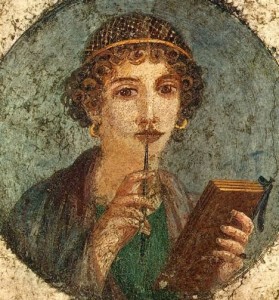 Roman Mural: Keeping Track of the Harvest: early uses for the cerata [11]
Roman Mural: Keeping Track of the Harvest: early uses for the cerata [11]
The final remediation [which never completely eliminated the use of the scroll], was the result of more than just shortages of materials or even practical considerations of which medium would be easier to use and to store. As has been indicated in many works, (Lunsford 2006) (Roberts 1984) (Szirmai, 1990), it was the early Christian church that completed the remediation of the scroll into the Codex. Not only was the church interested in establishing the primacy of a specific work [what later became known as “The Bible”], they were also very concerned with distinguishing themselves from other religions and from those in power, specifically the Romans.
The practical aspects of the decision to adopt the codex was also relevant, that is, the entire work known as the Gospels, was more readily packaged in the form of the codex. At the dawn of the new millennia this format was critical to the early dissemination of the first versions of the bible at a time when the church was actively promoting itself across Europe and was not yet in a position of power.
Finally, it was not only important to the early church that they distinguish themselves from the Romans with their pagan traditions but it was also important to them to demonstrate that they were different from the Hebrew religion and its scroll based traditions [as noted above].

Gutenberg Bible: later version of the ever evolving Book [12]
To sum up, the remediation of the scroll to the codex, occurred in tandem with the growing dominance of the Christian faith, which had established itself as a major force by the end of the fourth century [Gibbons, 1877). Writing, as a mode of communication, has been a hallmark of human civilization since the beginning of what has become know as history. History as a compilation of Writing, tracks a series of social, cultural and political transitions, involving the rise and fall of human cultures and civilizations over time through the lens of the dominant political and historical power structures and institutions.
Many of the same forces that shaped these historical shifts also determined the shape of the transition from Scroll to Codex. However, as has been shown, the remediation of this format for communication, was not straight forward and in the end was pushed not just by practical, economic or political forces alone, but also and importantly, in this instance, by the perceived needs of an emerging religion, that was soon to become a dominant force in the history of western culture.
References:
Bolter, J.D.(2001)Writing Space: Computers, hypertext, and the Remediation of Print
Lawrence, Erlbaum Associtates Inc. Mahwah, NJ, USA
Bottero, J., Herrenschmidt, C., & Vernant, J. P. (2000). Ancestor of the West: Writing, reasoning, and religion in Mesopotamia, Elam, and Greece.
Edney, M. H. (1992). Mapping the early modern state: The intellectual nexus of late Tudor and early Stuart cartography.
ETEC 540: Module 4:Literacy and the New Media
Digital Literacy and Multiliteracies
Habermas, J. (1986) Knowledge and Human Interests Cambridge, Polity Press
Lunsford, A. A. (2006). Writing Technologies and the Fifth Canon. Computers and Composition. 23, 169–177.
Mokyr, J. (2002). The Gifts of Athena: Historical Origins of the Knowledge Economy.
Roberts, C.H. (1984) The Birth of the Codex
Oxford University Press, USA
Digital References:
Szirmai, J.A. (1990) Wooden Writing Tablets and the Birth of the Codex
Gazette du Livre Medevale, No. 17
Also: retrieved online October 2009
http://cool.conservation-us.org/byorg/abbey/an/an15/an15-4/an15-407.html
Classic Encyclopedia Online (2006) 11th Edition, Encyclopedia Britannica
http://www.1911encyclopedia.org/Later_Roman_Empire
Reference: Gibbon’s Decline and Fall of the Roman Empire (1877)
The British Museum Online: What is Writing?
http://www.britishmuseum.org/explore/themes/writing/what_is_writing.aspx
Retrieved online: October 2009
The Israel Museum, Jerusalem: A Wandering Bible: The Aleppo codex
http://www.english.imjnet.org.il/HTMLs/article_453.aspx?c0=13815&bsp=13246
Retrieved online: October 2009
List of Digital Visual References: All images from Google Images
Retrieved: October 2009
[1] First Bible: one of the earliest versions of the Bible
[2] The Act of Writing: Artist’s conception
[3] Graffiti: Late twentieth century writing
[4] Ancient Greek Library: Artists rendition
[5] Early Egyptian Papyrus: {light type} Google Images
[6] Torah Scroll: one of the earliest parchment scrolls
[7] Trajan Library: A monument to Roman History: circa 53 – 177 a.d
[8] Early Greek Scroll: showing wooden rolling sticks
[9] Scroll Library of Qumran:
Reconstruction of Qumran’s Library (illustration S. Pfann, Jr.)
[10] Tabula Cerata: Example showing wooden stylus or pen
[11] Roman Mural fragment:
Keeping Track of the Harvest: early use of the Tabula Cervata
[12] Gutenberg Bible: example of the evolution of the Book
November 10, 2009 1 Comment
Ong on Plato – As a Reactionary: Commentary 1
Commentary #1 ETEC540
Commentary 1 :Orality & Literacy: Ong on Plato – As a Reactionary
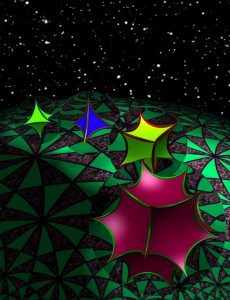
Above: Artist’s rendering of Platonic forms [retreived online Sept 2009]
Ong asserts, in his discussion [pp78-81] that Plato’s views about writing as expressed in the Phaedrus, demonstrate a reactionary response to the advent of writing, which was perceived by Plato as a threat to the primacy of orality and of the spoken word (Ong, 2002). Ong places Plato’s critique of writing along side similar critiques that have been issued by various figures over the course of the history of western culture during periods of technological transition. Ong mentions Hieronimo Squarcifico for example, who believed that the proliferation of books [circa 1477] was leading to a population that was less disciplined and less studious (Ong, ibid).
Resistance to technological change, and an investment in the status quo, were not the only characteristics of Plato’s views. According to Ong, quoting Havelock (1963) Plato’s entire epistemology “…was unwittingly a programmed rejection of the old oral, mobile, warm, personal interactive lifeworld of oral culture…” (Ong, ibid, pp79). He also states that Plato was “not at all fully aware of the…forces at work in his psyche to produce this reaction or overreaction…to lingering, retardant orality” (Ong, ibid, pp 80).
This discussion will explore some of the implications of Ong’s claims and examine the epistemological and philosophical underpinnings that provided support for Plato’s position. It will be shown that there was much more than just a resistance to a new technology, and a rejection of oral or written culture, involved in this critical stance about writing asserted by Plato. Plato’s denigration of writing and more generally about the role of art, was consistent with the ontological schema that supported his fundamentally mystical philosophical worldview.
A little background about the Phaedrus itself makes sense here. It is Plato’s famous work examining the nature of Love, through a dialogue purporting to be a discussion between Socrates and one of his colleagues Phaedrus. Important for our purposes here, it discusses some of the characteristics of writing and reveals also a critique of the role of artists [including poets] in society.
Ong lists four items that Plato suggests are wrong with writing; that writing is inhuman, that it destroys memory, that it lacks interactivity and that consequently it is passive. To understand why these characteristics and especially why interactivity was so critically important for Plato, it is necessary to understand the hierarchical nature of the Platonic world.
The highest discourse or reasoning procedure possible in pursuit of the ultimate virtue [Knowledge] is achieved through the interaction of oppositional pairs. Meaning is derived from the tension between two poles [one vs many, etc.] or is derived from the back and forth motion of thesis, ant-thesis and synthesis (Jones, 1970).

Ong fails to discuss the fundamentally mystical [not agnostic] philosophical system [The Forms, Hierarchy of Being] that supported Plato’s views. His hierarchical ontological schema [idealism] places man within a dualistic reality in which the world of sensory impressions [The World of Appearance] and observational data are not be trusted. That is, it is not the outside world [the world in which one makes scratches on paper or applies paint to canvas] that is the ‘essence’ of what it is to be human, nor, importantly, can one ever really know this outside world commonly referred to as ‘reality’. The ‘Essence’ of being, and the highest form of knowledge, can be apprehended through reason, it cannot be written down or ‘pictured’, made visible, etc.
Plato, using Socrates as his voice, sought a solution to the threat [as they both perceived it] of Sophist relativism, which they believed would lead to a society of moral anarchy. It was this perceived need to counter relativism that was largely responsible for Plato’s development of a rationalistic system and his concept of the Forms (Jones, 1970). Plato’s ideas about the nature of he Forms is complex, full exposition of the subject lies outside of the scope of this discussion.
However a brief synopsis of it is required to understand Plato’s hierarchical constructs of both reality and of the mind. Plato asserted that knowledge cannot be of nothing, of that which does not exist, and that real knowledge is eternally true and unchangeable. Therefore, the objects of knowledge, which he called Forms [or Ideas] must be eternal and unchangeable also. There is a form for every class of objects, [dog, table, beauty, god] and perceivable objects themselves are merely imperfect copies of the Forms.
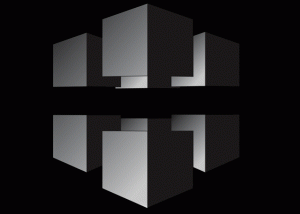
The nature of reality that unfolds from these crucial assumptions is laid out in the” The Republic” in the metaphor of he Divided Line wherein reality is segmented into a dualistic schema, the Intelligible World and the World of Appearances.
Important to his construct of the mind is the hierarchical division of states of mind, thus, within the World of Appearances and at the base of the hierarchy is Imagining [including the production of art], which is the lowest form of cognition. Ascending ‘up’ to the next level is a better way of perceiving, the realm of Belief. Within the Intelligible World, the first level of the states of mind is Thinking, where the first type of real knowledge [mathematical knowledge] is attained. Finally as one ascends to the highest level to the realm of the Forms themselves, one has the potential to achieve true Knowledge [gnosis], arrived at through the employment of dialectic reasoning.

In summary, although Ong correctly notes some of the objections to writing made by Plato, he is not just another exemplar of a reactionary, as it relates to historical change nor in terms of an example of a simple or binary rejection of oral versus written culture.
Writing in the Platonic world, like art production, takes place in the world of appearances. Therefore, it can only be a pale copy, a transcription of the process, [later refined and expanded in the work of Kant] of dialectical reasoning. Plato’s views on writing were not merely a reaction or response to, a transition from orality to written culture but rather, a logical outcome of the profoundly complex views expounded in his philosophy.

References:
Ong, W.J. (2002) Orality and Literacy, New York, NY Routledge, Publishers
Pages 78 – 81 Plato, Writing and Computers
Plato, excerpt from Plato’s Phaedrus [retrieved online September 2009]
Jones, W.T. (1970) The Classical Mind: A history of Western Philosophy, New York: Harcourt Brace Jovanovich, Publishers
October 4, 2009 1 Comment
Reflections on Process -Choose Your Avatar
Reflections on Process – Choose your Avatar:
![]()
In reflecting on the past module, along with the terms and content, I am also reflecting on the process of participating in the course itself, and the various challenges we encounter in successfully navigating the technological requirements of the module….. things like learning how to create a blog entry and in particular the process involved in choosing an Avatar. The notion of the avatar has been part of the virtual landscape for a long time, however the process of choosing one for these entries here [which I will no doubt change at some point] was for me, not as simple as it might sound. I found that I got lost a little bit in searching for something which could in some way represent me…. in some visual way …even just to find a picture that could be considered neutral….so I referred to the definition again…to refresh my understanding of the term
![]()
An avatar from the Sanskrit word for “a form of self”, commonly used in many Indian languages) is a computer user’s representation of himself/herself or alter ego, whether in the form of a three-dimensional model used in computer games, a two-dimensional icon (picture) used on Internet forums and other communities, or a text construct found on early computer systems It is an “object” representing the embodiment of the user. The term “avatar” can also refer to the personality connected with the screen name or handle, of an Internet user
Okay, that didn’t really help so I thought then….lets revisit what the term Alter Ego means….An alter ego (Latin “the other I”) is a second self a second personality or persona within a person. It was coined in the early nineteenth century when early psychologists first described schizophrenia. A person with an alter ego is said to lead a double life. The term alter ego is commonly used in literature analysis and comparison to describe characters who are psychologically identical, or sometimes to describe a character as an alter ego of the author, a fictional character whose behavior, speech or thoughts intentionally represent those of the author.[Wikipedia: retrieved September 2009].
In the end, I choose an old crest from one aspect of my identity [my surname] and one side of family to represent me here…like them its rather odd, but at the same time, it is also very familiar to me, I am not sure it represents my alter ego or even my Identity in any way, but it works for me now, because it is really is a kind of fusion of text, of symbol [icon] of identity and of technology….
September 21, 2009 No Comments
Text, Technology, Orality….becomes residual…
Topics/Writing is a drag/ questions from the first module/ personal definitions of Text and Technology, Orality becomes Residual….more questions…
I think we have had an amazing discussion in terms of defining Text and Technology…and Orality… as pointed out in the cambridge session…. someone always objects to a new technology….

Socrates: Writing is ‘inhuman’
Writing, Socrates argues, is inhuman. It attempts to turn living thoughts dwelling in the human mind into mere objects in the physical world. By causing people to rely on what is written rather than what they are able to think, it weakens the powers of the mind and of memory. True knowledge can only emerge from a relationship between active human minds. And unlike a person, a text can’t respond to a question; it will just keep saying the same thing over and over again, no matter how often it is refuted.
What is Orality? When It becomes….Residual
‘Residual orality’ refers to thought and its verbal expression in cultures that have been exposed to writing and print, but have not fully ‘interiorized’ (in McLuhan’s term) the use of these technologies in their daily lives. As a culture interiorizes the technologies of literacy, the ‘oral residue’ diminishes.
[This information was Retrieved from Wiki Reference: Orality, Sept 14, 2009]
Questions from Module 1:
What is Text? Text to me is synonymous with writing, it also infers content and meaning, that is, text without meaning or letters that don’t form words, would not be “text” but rather just an assemblage of letters, of strokes on a page. Text is meaning, a codification of meaning, but the whole point of text for me is to communicate, communicate what? Communicate meaning.
What is Technology?: means everything that involves technique, that involves a tool, so a pen is a type of writing technology….and language is a kind or technology of orality…etc.
What, for example, does textile have to do with text? Texts are tapestries or weavings of words to create meaning… just as threads are used to create a pattern, letters are used to create a pattern that describes a word, which in turn describes or outlines a meaning….
In the hopes that a visual is in order here….and to layer that onto our discussion, of course all I come up is…more questions…such as…
How is meaning communicated visually?
….Some consider music the highest art form, but just how does music “speak” to us?
How do sounds through speech really communicate meaning?convey Emotion?
Okay I will let the picture do the rest of the speaking here….Barb
September 15, 2009 No Comments
Technology, Text, Orality & the Body

Text Messenger- The Evolution of Texting, originally uploaded by s l i m d a n d y.
Hello Everyone,
Barb Fraser here. I choose this image because for me it is a very good visual representation of some of the concepts that are at play in this course. Technology, Text, Orality, the Body…. the very Human creation of Speech and expression of Thought realized as words, manifested either orally or in the form of text. Just like our subject matter this image is extremely complex and is comprised of multiple connotations and implied or inferred layers of meanings. Moreover the image itself issues out of a complex art genre [minimally; photography, mixed media, and surrealist art] and it “speaks” to a technologically advanced cultural milieu.
Specifically, it places text onto or within Technology [represented by a keyboard]. It then subsumes the physical body [that place where we imagine the text issues out of, that is the head or brain], specifically covering or replacing the mouth, again where speech, orality [non text based communication] or oral versions of text alone…are created/born. That is, it plays with the idea of the fusion of text not only onto and within technology but also within and through the vehicle of the body as a medium for the creation and the communication of text and also [implied] of speech and orality.
I have worked in health care all of my life in various management capacities, at BC Children’s, VGH and St. Paul’s Hospitals. Currently, I am happy to be working on campus [away from hospitals!] as manager of the MHA program here at the SPPH [School of Population and Public Health], UBC.
I am specifically interested in what makes online learning different [for example the F shaped scanning patterns of readers of text on line] from conventional learning and to better understand how to present e-learning content so as to maximize its advantages and compensate for some of its perceived disadvantages. I am a former psych major [originally art and psych], from Simon Fraser University and regard art and psychology as two of my primary passions in school and in life. I have somewhat eclectic interests and have an ongoing passion for film [Vancouver film festival et al], books, music, politics, and painting…
Look forward to learning with all of you….
September 9, 2009 No Comments

